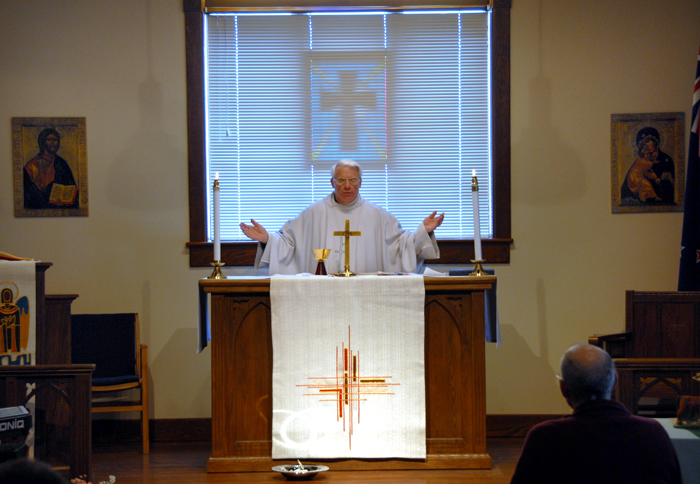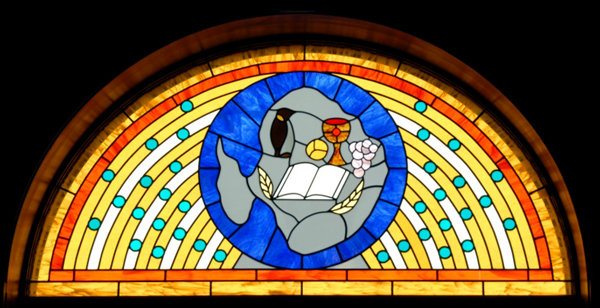
Photo Credit: Fleet Ratliff |
The Rev. John Jolliffe performs mass in the Chapel of the Snows at McMurdo Station. Catholic priests from New Zealand have performed a Midnight Mass on Christmas here for 50 years. |
50 years of blessings
New Zealand priests enjoy long history of serving the church in Antarctica
By Peter Rejcek, Antarctic Sun Editor
Posted February 1, 2008
The Rev. John Jolliffe had a lot to celebrate in 2007.
A Catholic priest from New Zealand, Jolliffe led the Midnight Mass on Christmas at the Chapel of the Snows at McMurdo Station. The event marked the 50th anniversary since the Rev. Ron O’Gorman of the Christchurch Diocese traveled via icebreaker to Antarctica to become the first Kiwi priest to celebrate mass on the Ice on Dec. 25, 1957.
“It’s a tremendous privilege, from knowing the heroism of the early explorers,” says Jolliffe the morning he’s preparing to fly home on a U.S. Air Force C-17 Globemaster III. “There’s a spiritual reality in a place where there’s life and death, where everyone realizes that they’re quite privileged being here.”
For the last 50 years, the Diocese of Christchurch has supplied chaplains to Antarctica, according to Jolliffe. It has also served the U.S. military members stationed in the South Island’s biggest city since Operation Deep Freeze first came to town in the mid-1950s in support of the scientific endeavor known as the International Geophysical Year (IGY). The IGY eventually morphed into the modern day U.S. Antarctic Program (USAP).
The military presence in New Zealand has shrunk since the U.S. Navy officially turned most of the support operation over to the National Science Foundation and its civilian contractors in 1999, though air support still comes from those who go to work in green suits. But the population and workload at McMurdo have steadily increased.
It’s the community and its science mission that attracts priests like Jolliffe and his replacement from New Zealand, the Rev. Tom O’Connor.
“I feel part of the history because of the jubilee at this time,” says O’Connor, who first served as the Catholic chaplain in 1982, and returned for his fourth trip only a couple of days ago. “I like to meet the people … and relate to them on a spiritual level as well as on a personal level.”
Both priests say that, despite popular perception, they see no conflict between religion and the science supported the by USAP. Both are particularly keen on cosmology, which studies the origins of the universe.
Jolliffe says that while at the South Pole Station, a Catholic religious brother, a scientist with the Vatican Observatory in Rome, summed up the partnership between science and religion quite nicely: “Science studies how the world is made. Religion studies who made the world. And why would I not want to know how my friend made the world?”
O’Connor adds, “We’re just discovering what God has done in the world and how God made it.”
The austral summer season always has two chaplains on the Ice — a Protestant from the U.S. Air National Guard and a Catholic priest from New Zealand. Both are stationed at McMurdo, but also make occasional trips to the South Pole. There is a strong ecumenical spirit in services and chapel activities.
“We’re very aware that the atmosphere has to be one of community, [chaplains must be] unique people who can get along by themselves and with a lot of different people,” Jolliffe says.
Indeed, as Jolliffe and O’Connor explain their mission here, they speak in broad spiritual terms, marveling at the sense of wonder a trip to Antarctica can produce.
“When you come here there is a sense of awe, that there is a power far beyond yourself. And you have to obey that power or you’re dead,” Jolliffe says. “I think it’s [about] the adventure with other people, and being on the journey with them and their spiritual journeys … it’s good to be alongside them in such a unique environment.”
Photo Credit: Fleet Ratliff
A stained glass window in the chapel.
The naval men who first established McMurdo Station in the 1955-56 summer season must have recognized Antarctica’s spiritual essence. The Chapel of the Snows had not appeared in the 1956 plans for McMurdo Station. Religious services were to be held in the mess hall.
The base’s first Catholic priest, the Rev. John C. Condit, had other ideas. With the help of volunteers, he procured building materials and set to building a nondenominational chapel on a knoll during their free time.
Adm. George Dufek, one of the officers in charge of Operation Deep Freeze, noted, “Before the main camp was finished, a tidy neat church with a steeple was to stand on a ridge overlooking the camp. Later it even had a bell, procured from a small gasoline tanker.”
A fire destroyed that building in 1978. The present-day chapel was built in 1989, and it is used for services and Bible studies, as well as other community activities such as yoga classes.
“It’s a fascinating and stimulating environment, and to be a part of that community where we play a part in the morale … is great,” Jolliffe says.






